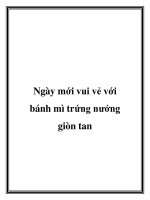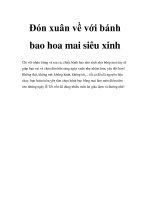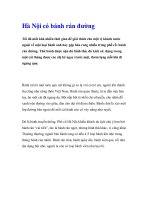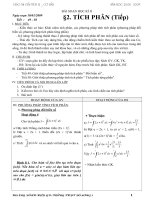Học vẽ cơ bản
Bạn đang xem bản rút gọn của tài liệu. Xem và tải ngay bản đầy đủ của tài liệu tại đây (21.8 MB, 22 trang )
observe imagine
Sketcher Spotlight: Juan Arroyo
Fall 2009-Spring 2010
DRAWING
LEAGUE
Draw Your Future
DRAWING
LEAGUE
www.drawingleague.blogspot.com
see what our students are drawing
observe imagine
I
take my work as a drawing coach very seriously. On the very first day of
lessons, I put Drawing League students to the task of sketching accurately from
observation. Many start out by saying they don’t know how to draw–like Miranda
from the San Lorenzo Valley in Santa Cruz, California. (See her ink drawing of
an eye shown above to see otherwise.) It gives me great pleasure to help students
see the world from a different perspective and make their ideas visible through
drawing. As the weeks progress, it’s a joy to see students become confident,
observant sketchers and to see them unleash their imaginations in creating
powerful, artistic compositions. Take a look at the drawings on the following
pages, and perhaps you will agree that these students appear to take their work
seriously too.
–Rob Court, drawing coach, founder of the Scribbles Institute www.robcourt.com
Please visit www.drawingleague.blogspot.com to view work by all Drawing League students.
Special thanks go to Sandy Mast, Gary Vincent, and Kevin McClelland for making
it possible to bring the Scribbles Institute Draw to Learn program to their Central
Coast school districts. I’d also like to thank the Santa Cruz Mountains Art Center
for providing their wonderful facilities for my adult Draw the Moment classes.
And, of course, thanks to all the students and teachers I had the privilege of
working with during the year.
On the cover: photo: Juan Arroyo, Rancho Cielo Youth Campus; apple study sketch by Matt,
Santa Cruz Mountains Art Center; abstract drawing by Zach, Highlands Community School
Printed and downloadable versions of Drawing League magazine are available online at
www.drawingleague.blogspot.com or www.scribblesinstitute.com
1
Drawing League Magazine Fall 2009 - Spring 2010
1
2
Welcome
to the premier issue
of Drawing League, published by the
Scribbles Institute. The purpose of
this periodical is to exhibit student
work and to serve as a forum for their
thoughts about the world of drawing.
As our community of sketchers grows
and evolves, so too will this magazine.
In this issue you’ll find student work
from Fall 2009 through Spring 2010.
The work shown on the following pages
is by high school students in our Draw
to Learn program. Participating schools
are in Santa Cruz County, Monterey
County, and the Monterey Pennisula
school district. Work by adult sketchers
in our Draw the Moment classes and
workshops is also featured.
Drawing League Goals
• Help students to realize their innate
drawing abilities
• Develop each student’s drawing
skills based on his or her
particular interests
• Help students to transfer their
drawing skills to school and/or
work projects
• Guide students in exploring careers
that utilize drawing skills
left page:
1. Skull study by Juan Arroyo,
Rancho Cielo Youth Campus,
Salinas
2. Aztec god, Tonatiuh by Marcial,
Success Academy, Watsonville
right page:
3. Pencil warmup by Emily,
Highlands Community School,
Santa Cruz
Photos:
Students at Highlands Community
School cut loose with woodless
graphite pencils while learning
about contour edges and tones
Observe, Imagine
The lessons in our programs are
designed to build strong observa-
tional skills and develop the power
of imagination–essential tools for
students of all ages. This issue of
Drawing League is devoted to works
from observation and imagination.
As our students learn basic drawing
skills and techniques, they also learn
about the elements of visual art:
lines, shapes, patterns, form, texture,
space, light, and color. We’re proud
to exhibit student work from the
lessons. Enjoy!
3
“It is not enough to believe what you see, you must also understand what you see.”
–Leonardo da Vinci
photo: Adult sketchers at Santa Cruz
Mountains Art Center (SCM Art Center)
learning to layer Prismacolor pencils
1. Contour study of flowers
by Michele, SCM Art Center
2. Impressionistic sketch of the form and color
of an apple by Allison, SCM Art Center
3. Contour, tonal sketch of squash
by Matt, SCM Art Center
4. Contour, texture, tonal study of artichoke
by Allison, SCM Art Center
5. Contour, texture study of pumpkin
by Miranda, Highlands Community School
6. Contour, tonal study of sea shell
by Lizette, Salinas Community School
Observation
1
2
4
3
4 5
6
5
3
2
1
left page: 1. Drawing of dog while studying proportions, contour
lines, and tonal values by Raquel, Star Community School
2. Drawing of wolf while learning about form, contour lines, and
texture by Leydi, Salinas Community School
3. Impression of a lily by Shaylah, Highlands Community School
right page: 4. Helen, from SCM Art Center, snaps pics of her
contour study sketches of an artichoke and squash
5. Contour line and tonal value drawing of an aloe plant
by Lorenzo, Monterey Community Day School
above photos: Sketchers at Star Community School
6
D
eveloping strong observational skills is a primary
focus of Drawing League students. On the first day
of class everyone draws with lines and shapes while
learning to measure proportions. Students progress
quickly as they learn about form, contours, and
tonal values. They draw from photos, real life, and
artwork by masters such as Leonardo da Vinci, Van
Gogh, Degas, and Kandinsky.
From Tentative Beginners to Confident Sketchers
Compare lessons done by Drawing League students on their
first day of class, to their more advanced work shown on
pages 4 and 5. Shown above, clockwise, starting at top:
puffer fish by Helen, SCM Art Center; toucan by Lorenzo,
Monterey Community Day School; crab by Shaylah,
Highlands Community School; dinosaur and frog (lesson
on overlapping) by Leydi, Salinas Community School;
crab studies by Raquel, Star Community School
4
5
7
8
1-3. Study sketches and final drawing of a
dragonfly by Sharon, SCM Art Center. She
‘blocked in’ basic shapes for the dragonfly’s
wings and body in her studies; then made
corrections for the position of wings and angle
of body before finishing with contour lines.
4. Drawing by Sharon, SCM Art Center, shows
negative space around the egret with contour
edges and tonal values.
5, 6. Study and final drawing of an egret by
Allison, SCM Art Center. Her study shows
how she used the negative space around the
bird to find accurate proportions. Allison’s final
drawing shows contour edges and how she
used tonal shading and erasing highlights to
show the form of the egret.
Realistic drawing can be a challenge for beginners
as well as advanced sketchers. Learning about negative space
and contour edges are pivotal lessons in perceiving realistic,
accurate proportions. Drawing League students learn to
‘think’ on their paper as they sketch basic shapes before
finishing with contour lines. Drawing on top of, or through,
mistakes in measuring proportions is emphasized.
1
2
3
4
5
6
9
Drawing from the ‘Crate of Realism’
Learning to Draw Objects
from the Real World
Rob Court, drawing coach,
occasionally rolls the crate of
realism into class and students
select objects to begin their
study sketches of proportions,
contours, and textures.
photos: objects await the
observant eyes and diligent
sketching hands of students
from Salinas Community
School (top, right) and High-
lands Community School
7. Stapler by Arianna,
Highlands Community School
8. Canine skull by Pedro,
Salinas Community School
9. Antique iron by Thalia,
Monterey Community
Day School
10. Lantern by Jamee,
HighlandsCommunity School
7
8
9
10
Stipple Effect With Ink
Technique
Sketching Like Vincent Van Gogh
Working from drawings by Van Gogh, students studied perspective, composition, and textures.
White Pencil on Gray Paper
by Matt G., Highlands Community School
10
By Nathaniel, Success Academy
By Shaylah, Highlands
Community School
By Val, SCM Art Center By Elvis, Highlands Community School
By Nathaniel, Success Academy
By Hilda, Highlands Community School
By Kirsten, SCM Art Center
By Gage, Highlands Community School
11
Cross-Hatching Lines
3D Perspective
By Miranda, Highlands Community School
By Brianna, Star Community School
1. Classroom ceiling by Zach,
Highlands Community School
2. Classroom by Emily,
Highlands Community School
3. 2-point perspective by
Matt, SCM Art Center
4. Classroom bookshelf by
Patty, Highlands
Community School
1
2
3
4
Imagination
is more important than knowledge.
–Albert Einstein
“
”
12
Spontaneous drawing by Emily, Highlands Community School
Einstein by Keeley (left) and Hilda (right),
Highlands Community School
13
1. 2-point perspective by Natalie, Highlands Community School
2. By Natalie, Highlands Community School
3. By Patty, Highlands Community School
4. By Zach, Highlands Community School
5. Inspired by the artist Mondrian, by Bryan,
Salinas Community School
6. Inspired by the artist Kandinsky, by Darrian, Success Academy
1
5
6
4
3
2
14
1
3
4
5
2
15
left page:
1. By Matt G., Highlands Community School
2. By Zach, Highlands Community School
3. Abstract drawing by Brian, Monterey
Community Day School
4. By Wells, Rancho Cielo Youth Campus
5. By Zach, Highlands Community School
right page:
6. Abstract by Zach, Highlands
Community School
7. Abstract by Lizzy, Star Community School
8. By Matt G., Highlands Community School
6
7
8
A
lthough he doesn’t consider himself an artist, if
you ask his classmates who the ‘artist’ at school is,
they’d probably name Juan Arroyo. Juan attends
Rancho Cielo Youth Campus in Salinas, California
and is passionate about drawing. “Drawing is
important for me because I love to draw what I
have inside of me and what I imagine,” says the
soft-spoken senior.
Whenever Juan wants to pass some time in school
or at home he picks up a pencil and draws, and
draws, and draws. His consistency all year long in
drawing class is amazing. After finishing his daily
lesson he effortlessly jumps into a drawing of his
own, often straight from his imagination or from
reference pictures. When asked what inspires him
he simply replies, “Silence is the inspiration for
me, sometimes music.”
Juan Arroyo
Age: 17
School: Rancho Cielo Youth
Campus, Salinas, California
Hometown: Salinas, California
City of Birth: Michoacan, Mexico
Favorite Music: Mexican
Pets: Dog
sketcherspotlight
16
17
Juan remembers drawing cars as a 9-year-old
and it’s been non-stop sketching ever since.
Equally adept at drawing from observation
or from his imagination, his pictures depict
historical scenes, symbolic stories, or surrealist
compositions. One can see the strong influences
of his Mexican heritage and the local street art
scene in his work. As a sketcher, Juan is largely
self-taught and enjoys experimenting with a
variety of drawing media. His latest work with
4B and 6B graphite pencils on large-format
paper captures the viewer with bold strokes and
powerfully-shaded tones.
Juan Arroyo is planning to study criminal
investigation after graduating from Rancho
Cielo. But we can rest assured that his enjoyment
of drawing will be a part of his future. Before
getting back to the elaborate drawing on his
desk he quietly says, “I just draw for fun and
because I like it.”
The size of Juan Arroyo’s pencil
and graphite drawings shown range
from 8.5 x 11 to 18 x 24 inches.
I
magine yourself playing your favorite sport.
Forgetting all limitations, you perform flawlessly
and are unstoppable as you tally up point after point.
You’re in a state of mind where time is suspended
and movement flows without having to think of
fundamental skills. This is called being in the Zone,
and it is the state of mind you want to strive for
while drawing.
Being in the Zone is when the intense concentration
on what you’re drawing gives way to effortless zen-
like pencil strokes. It’s as if your drawing hand takes
on a mind of its own, while lines and shapes flow from
your pencil tip. For beginning and advanced sketchers
alike, finding this blissful state of transcendental
drawing can prove to be elusive and challenging.
Highlands Community School sketchers show that doodling is
a great way to drop into the Zone.
Baseball legend Yogi Berra famously said, “Ninety
percent of hitting is mental, the other half is physical.”
And so it also goes in drawing: much of the process
is mental, even before pencil meets paper. Letting go
of preconceived notions about drawing and training
yourself to see like an artist will help you start
mental conditioning. Taking your drawing skills into
the Zone–and staying there for extended periods of
time–takes a special mindset indeed.
3 Ways to Draw Yourself Into the Zone:
Be the Pencil: Visualize Drawing
Like an athlete in training, envision yourself with
pencil in hand, poised and confident, your arm
gliding effortlessly through long, graceful arcs.
Picture yourself laying down guidelines and accurate
construction lines, making corrections, and finishing
your drawing with artistic flair. The artist Andrew
Wyeth once said, “I dream a lot. I do more painting
when I’m not painting. It’s in the subconscious.”
Dream about drawing.
Eliminate Distraction
Music can help you focus and get deeper into your
drawing. Maybe the sounds of ocean waves or wind
rustling through trees will trigger your mood for
inspired sketching. For Juan Arroyo, a high school
student in Salinas, California, silence is his preferred
mode for getting in the Zone. It’s important to find a
special place where you can focus on matters at hand,
silence your inner critic, and draw out your
inner artist.
Be Spontaneous
Random acts of doodling are excellent for prying
open the doors of creativity and stepping into the
Zone. Experiment. Loosen up your line work. Draw
on top of mistakes: let errors and corrections add to
your composition. Embracing mistakes, then getting
past them, gives way to the spirit of discovery. And
then the real fun begins!
Drawing can be a very productive meditation.
Whether drawing from observation or imagination,
it takes effort to find the Zone, just like when you’re
playing sports. But with practice it gets easier and
easier to naturally drop into it. Keep pencil to paper,
push your drawing abilities into uncharted waters.
Suddenly, unexpectedly, you’ll feel the cerebral shift
as the gravity of the Zone pulls you into its orbit.
Once there, each pencil stroke will feel like it’s being
channeled from a fearless, profound place where
anything is possible. –Rob Court
18
Star Community Sketchers in Santa Cruz, California, share an iPod
as they work through a challenging observational drawing lesson.
In the Zone: Becoming One With Your Pencil
DRAWING LEAGUE
www.drawingleague.blogspot.com
If you’re a Drawing League student and want to submit work for our ‘Live 2 Draw,
Draw 2 Live issue, talk with Rob after drawing class
Live 2 Draw, Draw 2 Live
Next Issue:
Learn Basic Drawing Skills for Work, School, and Enjoyment
•
K
n
o
w
Y
o
u
r
I
m
a
g
i
n
a
t
i
o
n
•
D
e
f
e
n
d
Y
o
u
r
I
d
e
a
s
•
L
i
v
e
t
o
D
r
a
w
•
D
r
a
w
t
o
L
i
v
e
S
C
R
I
B
B
L
E
S
I
N
S
T
I
T
U
T
E
.
C
O
M
Drawing is a Tool
That Improves Your World
For info about our books and classes for Santa Cruz, Monterey,
and San Jose, Counties go to www.scribblesinstitute.com
Our programs
are perfect
for parents, teachers,
students, business owners,
artists, designers, engineers,
corporate executives, retirees
—anyone with the desire to
learn basic drawing skills and
apply them to everyday life.
What Do You Want to Draw Today?
Our books
are for sketchers of all ages who wish to improve their
drawing. Printed and eBook editions are available. Our publications
and videos are devoted to serious fun in drawing.
From acncient pictures on cave walls,
to Leonardo da Vinci’s scientic renderings,
to present-day sketches on an iPhone,
drawing remains an essential tool used by
cultures the world over.
Whether you’re interested in drawing as a
hobby or on the job, the Scribbles Institute
is here to help you get started. Learn to use
drawing for expressing ideas, taking notes,
organizing information, solving problems,
and creating visual art.
Draw to Learn lessons are designed for
public and private schools, charter schools,
alternative education sites, and home schools.
Draw the Moment workshops are ideal for
community organizations, art galleries,
parks and recreation facilities, and senior
living programs.









